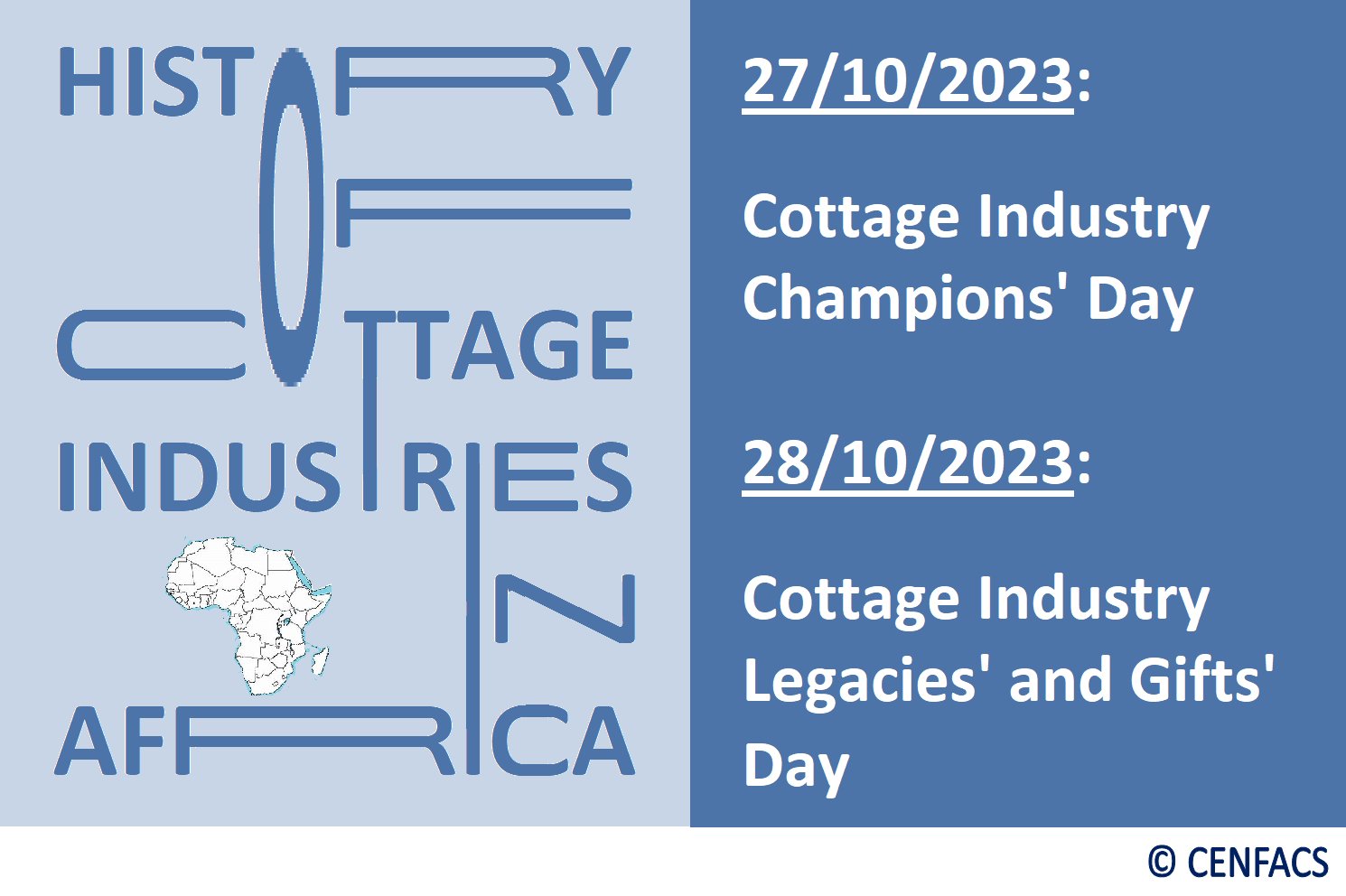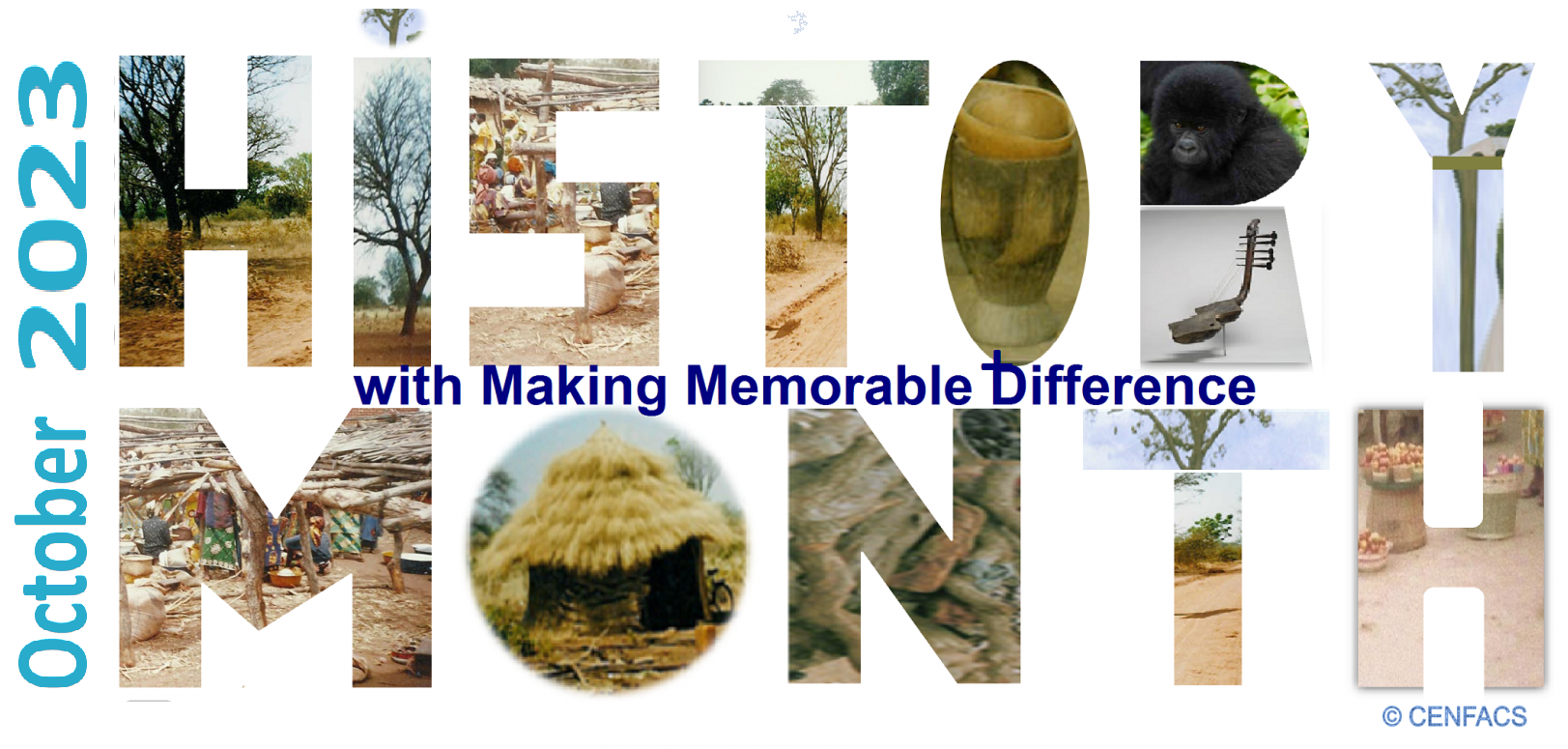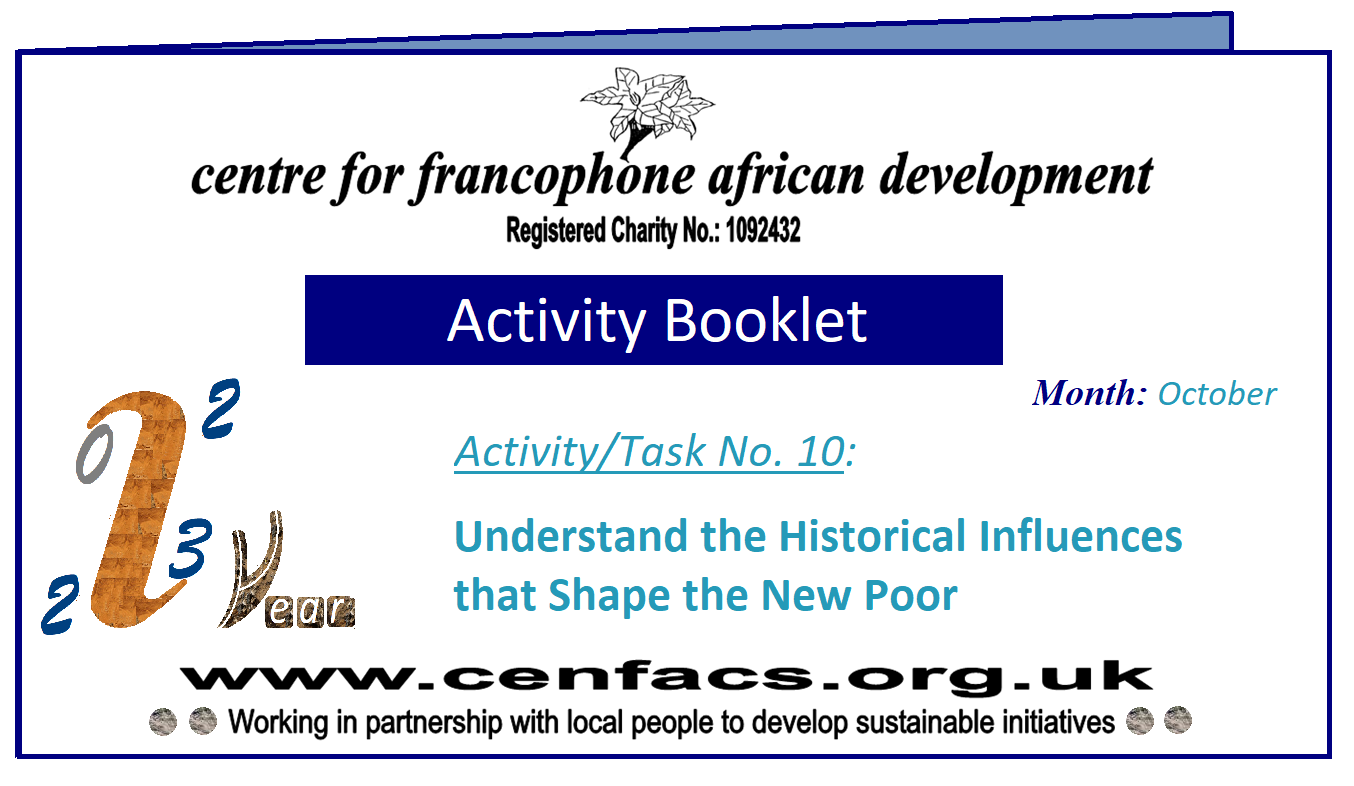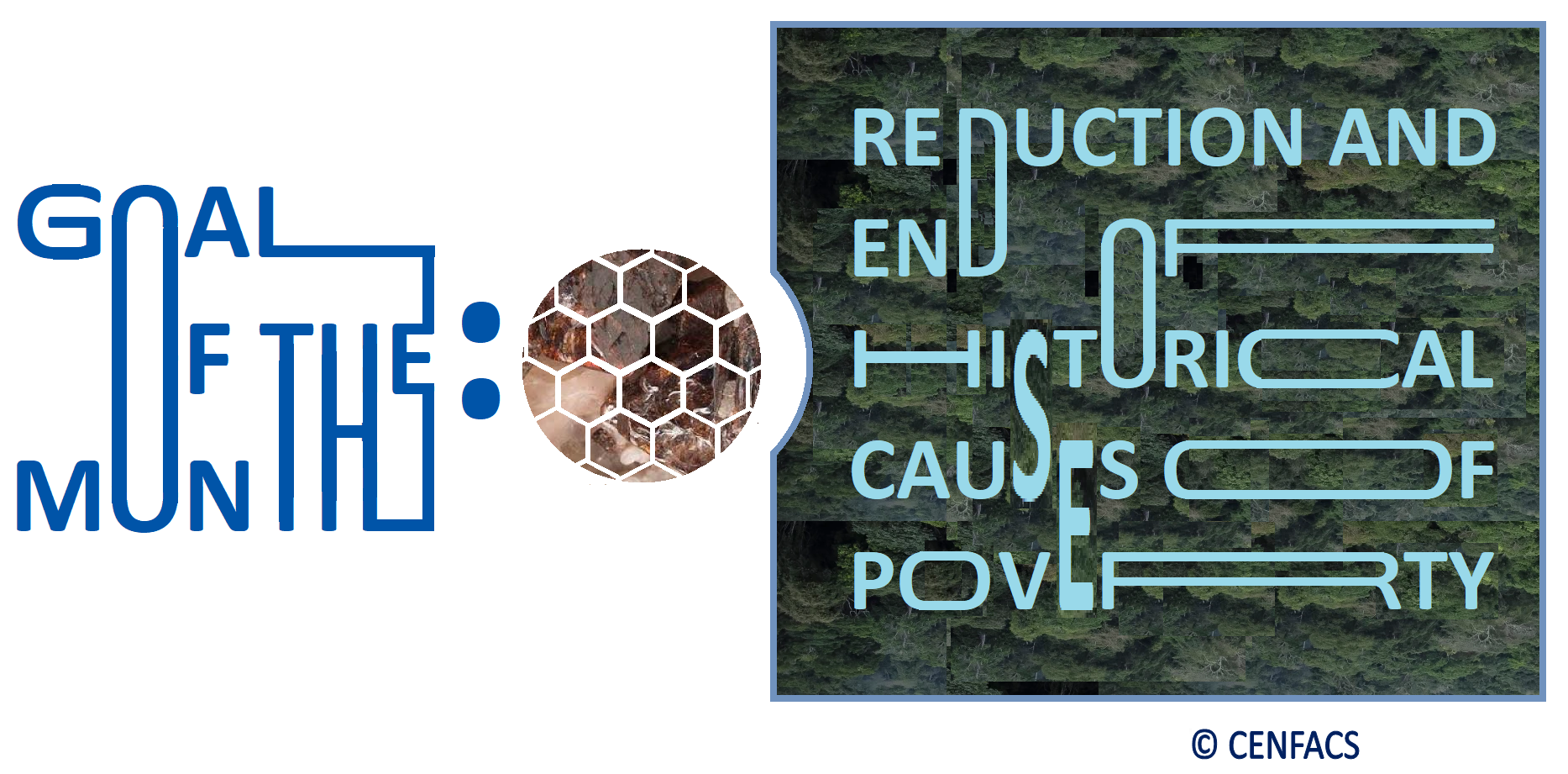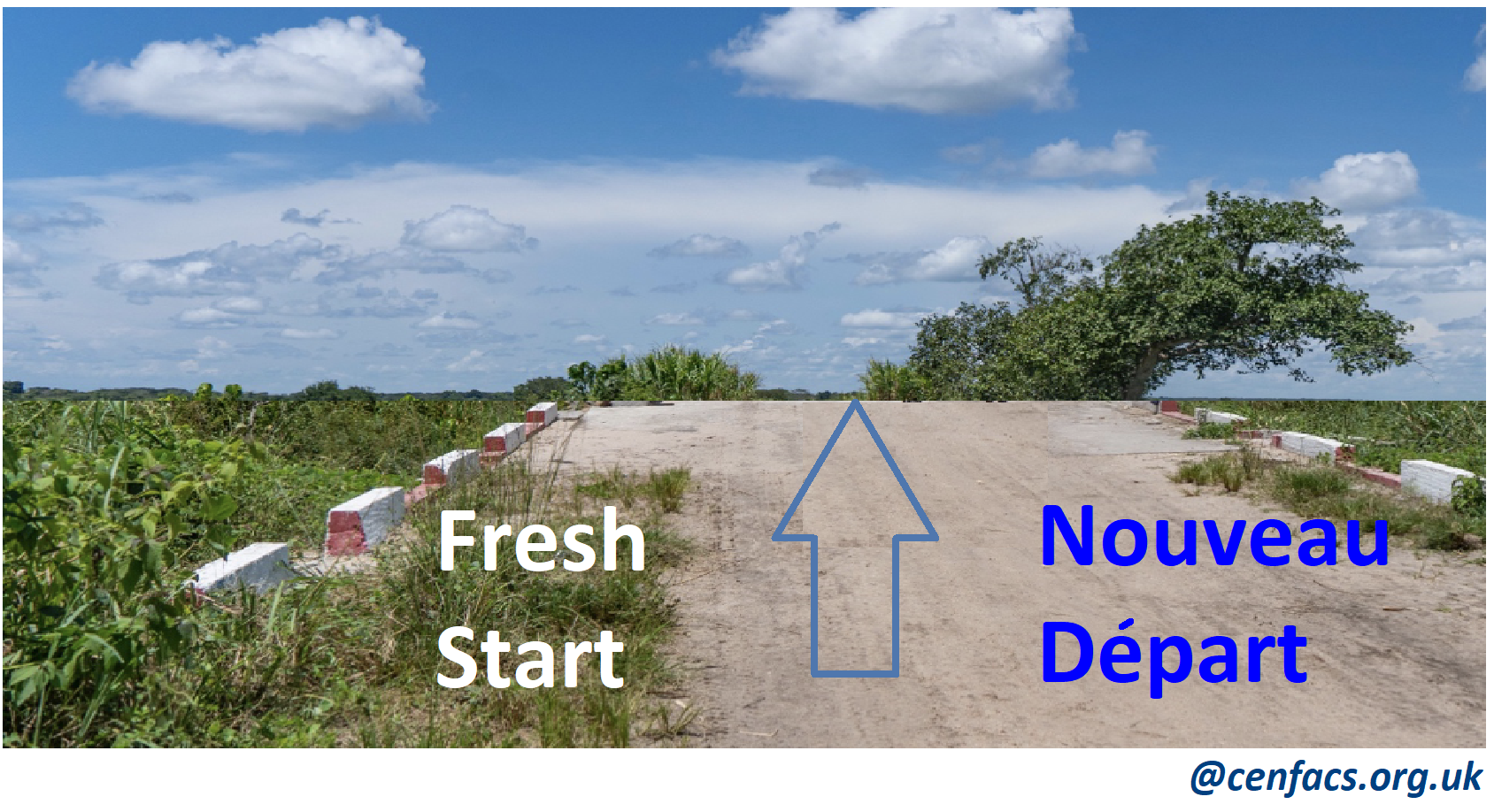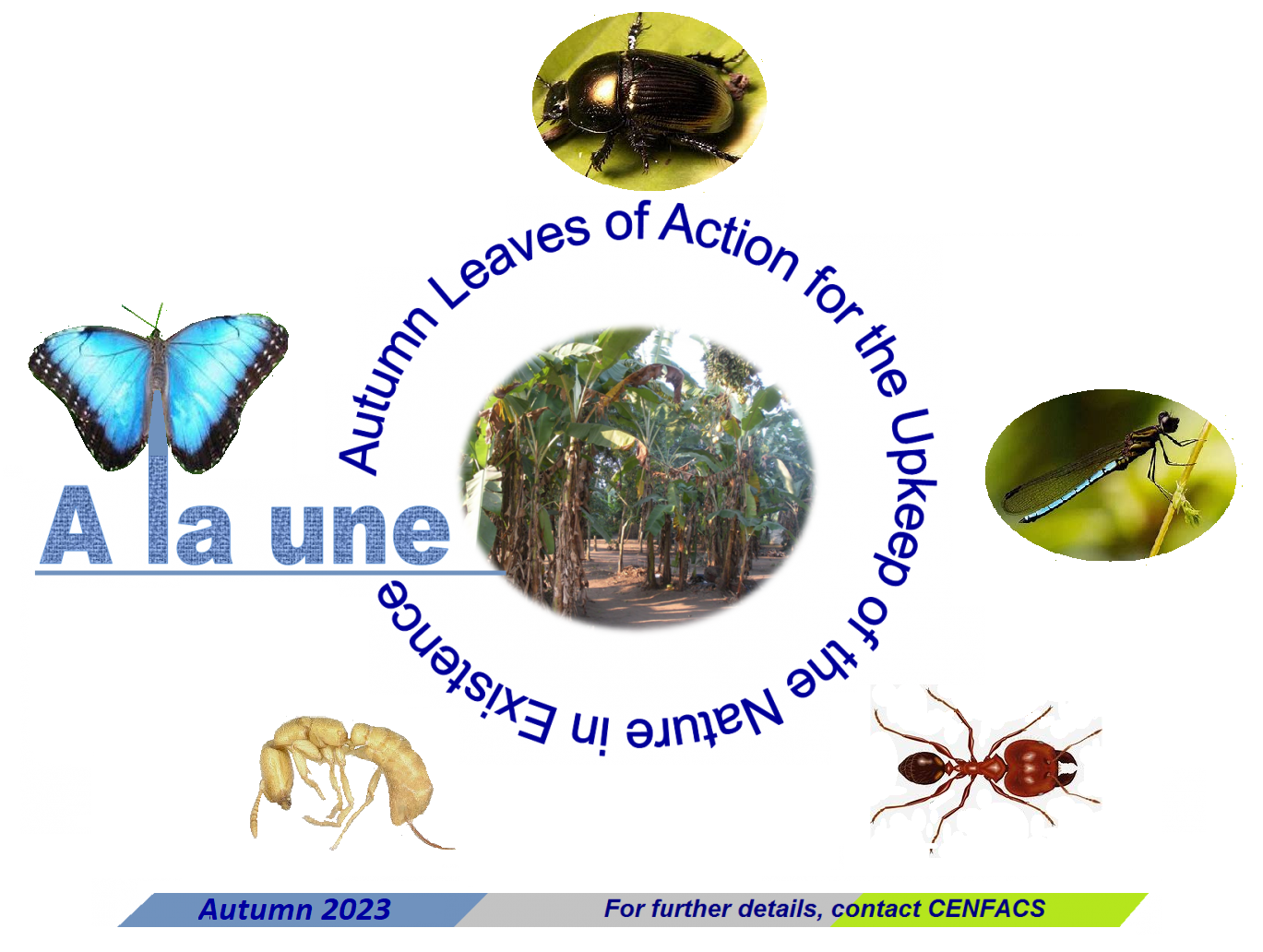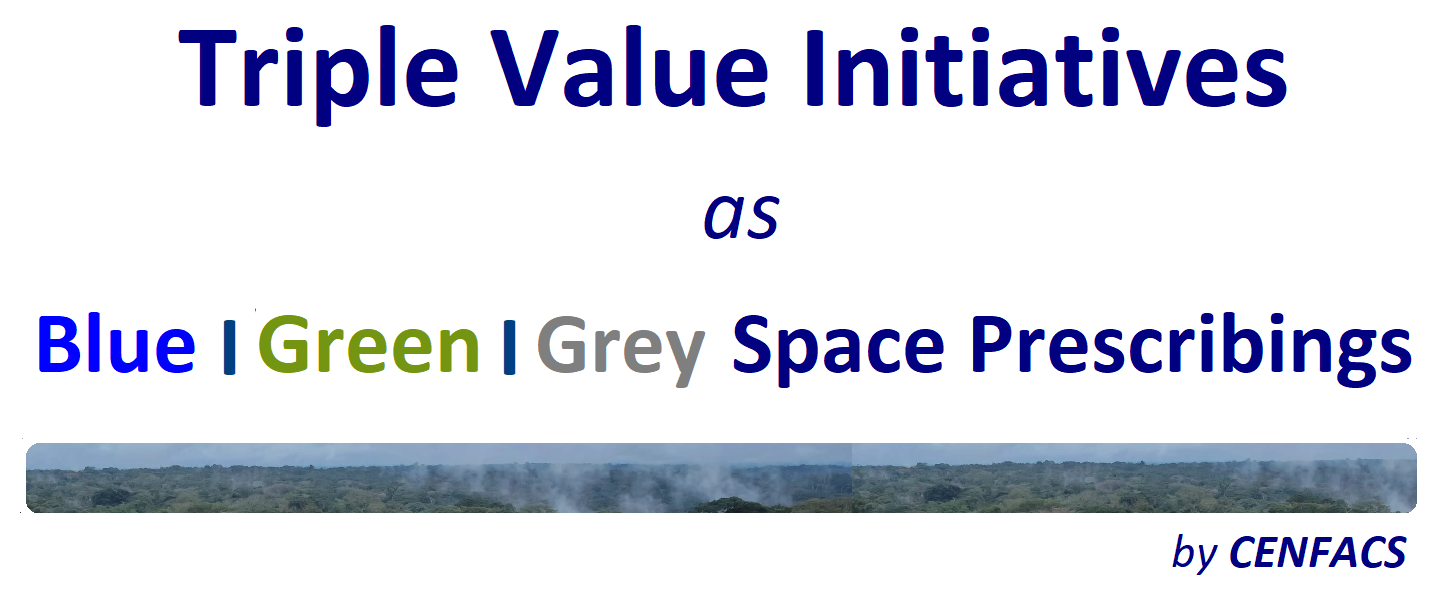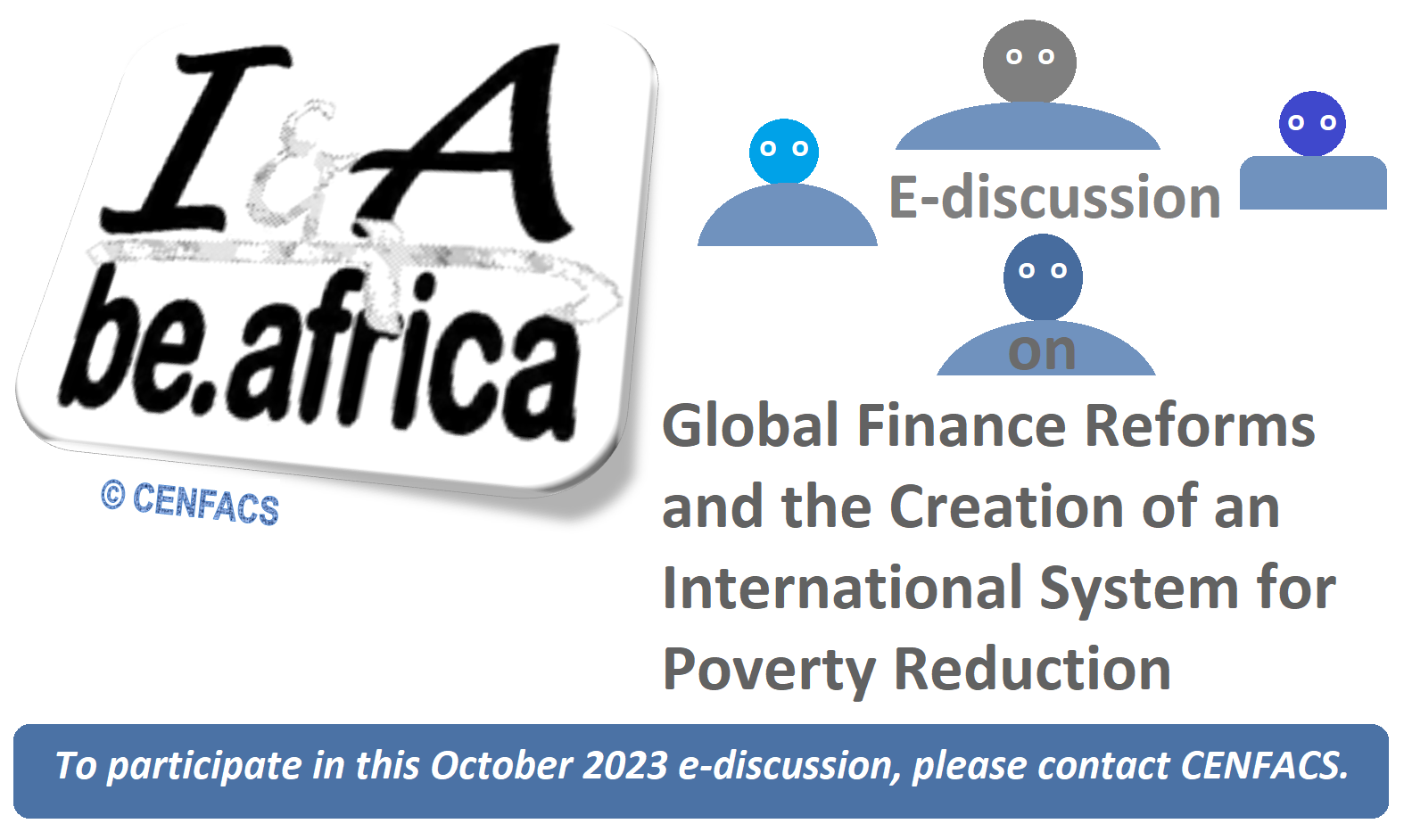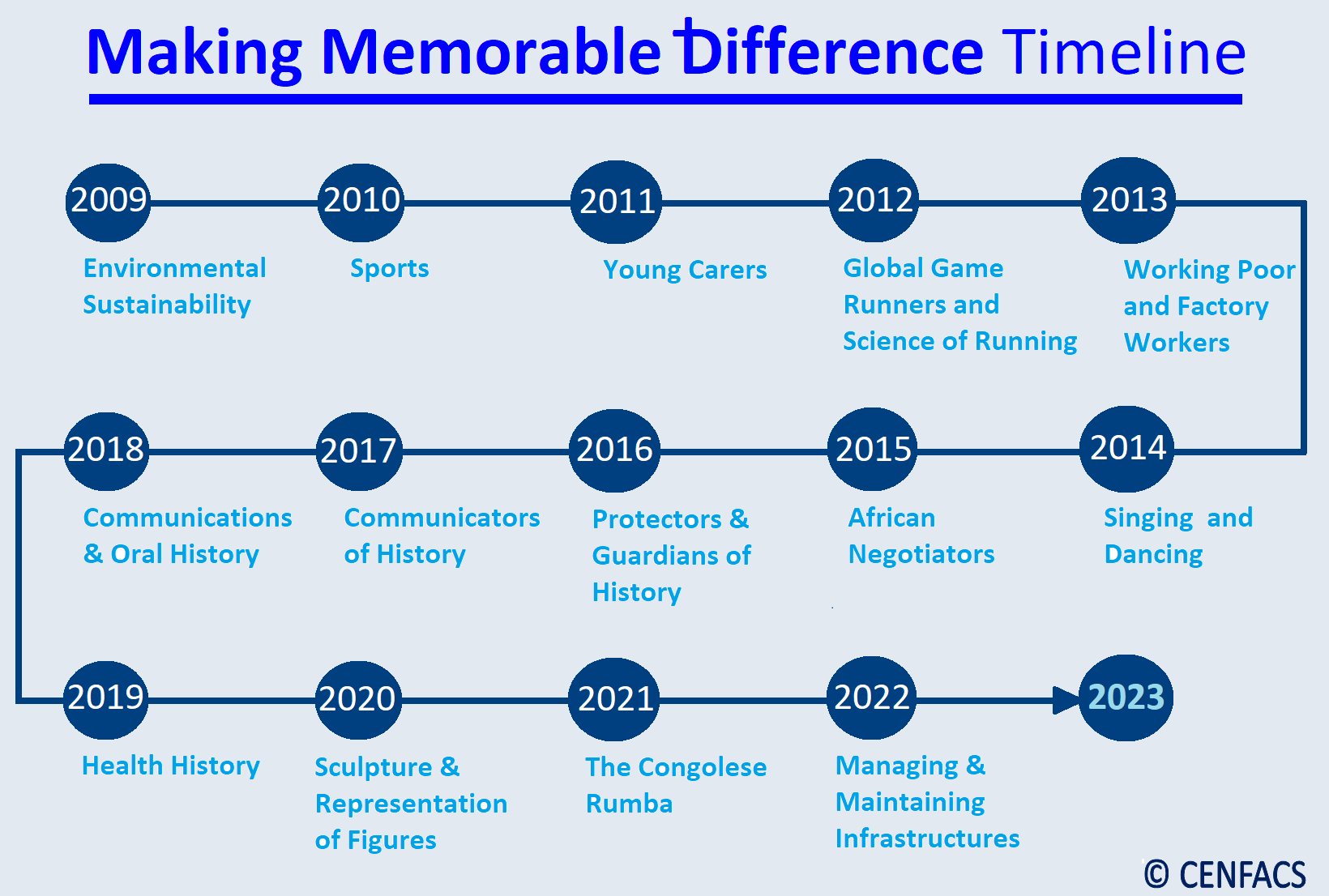Welcome to CENFACS’ Online Diary!
04 October 2023
Post No. 320
The Week’s Contents
• History Month with Making Memorable Positive Difference Project – In Focus: History of Cottage Industries in Reducing Poverty in Africa
• Activity/Task 10 of the Influence (‘i’) Year and Project: Understand the Historical Influences that Shape the New Poor
• Goal of the Month: Reduction and End of Historical Causes of Poverty
… And much more!
Key Messages
• History Month with Making Memorable Positive Difference Project – In Focus: History of Cottage Industries in Reducing Poverty in Africa
This year’s Making Memorable Positive Difference (MM+D), which is the 15th one, will blend fact of the history of industries in Africa; in particular that of Cottage Industries in Africa in their capability in reducing poverty.
Cottage industries were the backbone of many economies in Africa until the age of the policies of industries industrialising and industrial development. Until then, cottage industries contributed to livelihoods and rural development. But, what is a cottage industry?
Referring to ‘ipcinfo.org’ (1), a cottage industry is
“An industry-primarily manufacturing – which includes many producers, working from their homes, typically part time”.
It was a system of subcontracting manufacturing work to families or home workers. These home workers were engaged in tasks such as sewing, woodwork, pastry production, lace-making or household manufacturing, etc. With the era of modern green industries and industrial enterprises, many of products from cottage industry are forgotten. However, during the coronavirus disaster many people and households turned to cottage industries in making their soaps, face masks, medicine (e.g., hand sanitiser), etc. as many of these industries are and remain part of the essential economy.
As part of MM+D 2023, we will remember the history of industries in Africa; in particular that of Cottage Industries in Africa in their capability in reducing poverty within their own household and beyond their household. We shall as well reminisce those who set up and ran them. MM+D 2023 will provide opportunity to remember the forgotten products of the cottage industries and these industries themselves.
We shall look at the history and business model of household-based industries in reducing poverty in two ways:
a) the profiles of household-based industry proprietors and labourers
b) the assessment of the historical contribution of the household-based industries in reducing poverty and in creating wealth in Africa.
Our historical reference point or period of remembrance is any time before the age of the policies of industries industrialising and/or industrial development in Africa (that is, before the first industrial development decade for Africa, before 1980-1990).
Briefly, the focus for this October History Month will be on Cottage Industries in Africa or Household-based Industries in their capacity and capability of lifting people out of poverty. Our work for this year’s MM+D will be about identifying the historical figures (and families) of Africa who could be called the Champions of Cottage Industries or Industrious Proprietors (or Families) of Poverty Reduction.
For further information on this acknowledgement about Cottage Industries in Africa in their capability and capacity in reducing poverty and creating wealth, please read under the Main Development section of this post.
• Activity/Task 10 of the Influence (‘i’) Year and Project: Understand the Historical Influences that Shape the New Poor
The 10th Activity or Task of our ‘i’ Year and Project is about Understanding the Historical Influences that Shape the New Poor.
People who suffer from poverty and hardships may have some root causes or historical influences that could have been at play for them to be in the difficult conditions they are in. This can concern the new poor or new types of poverty. But, who are the new poor and what is historical influence?
• • Defining the New Poor
The new poor can be defined in many ways. In this Activity/Task 10, our definition of the new poor comes from ‘worldbank.org’ (2) which explains that
“The new poor are those who have been pushed into extreme poverty by the coronavirus… The new poor are those who are expected to be non-poor in 2020 prior to the coronavirus outbreak but are now expected to be poor in 2020.”
‘Blogs.worldbank.org’ (3) goes further in arguing that
“The new poor are a combination of those who would have exited poverty in the absence of COVID-19 but are now projected to remain poor and those projected to fall into poverty because of COVID-19”.
These new poor could be urban or rural. The urban poor profiled include working-age adults and paid employees. They have secondary and tertiary education and are less self-employed.
If we consider the period of the cost-of-living crisis, the new poor would be those who have been pushed into poverty by the cost-of-living crisis.
The above-mentioned definitions contain some influencing factors that help in the process of shaping the new poor.
• • Understanding Historical Influence
The definition retains here for historical influence comes from Study Buff (4) which states that
“Historical influence is concerned with or treating of events of the past, historical accounts, based on or constituting factual material as distinct from legend or supposition, based on or inspired by history”.
It is useful to understand these events of the past that have shaped and influenced history to get to know what makes the new generations of poor today. To do that, one can use their lenses (social, political and economic lenses).
• • Examples of Understanding the Historical Influences
One can use the events of the coronavirus lockdowns as a historical influence that shape the new generation of poor. One can as well look into the economic recession of 2008 if there is any link with the new types of poverty. One can finally bring their own historical perspective and see how it fits in within 10th Activity or Task of our ‘i’ Year and Project. This will help understand why some types people living in poverty behave in a certain way.
The above is the Activity or Task no. 10 for the ‘i’ Year/Project for those who are interested in carrying it out. For those who want any clarification of any aspects of the activity or task, they can contact CENFACS.
• Goal of the Month: Reduction and End of Historical Causes of Poverty
Poverty can have many causes and routes. Amongst its causes are the historical ones. Our goal for the month of October 2023 is the Reduction of Historical Causes of Poverty. To deliver this goal, we need to understand it and work with those who may likely experience this type of poverty.
• • What is the Reduction or End of Historical Causes of Poverty?
It is about cutting down or eliminating the factors that generate a cycle and persistence of poverty throughout poor people’s history and life. These factors or historical causes can be of various kinds.
These historical causes can be endemic structural disadvantages, structures of discrimination, disadvantage in terms of opportunities and access to resources, non-respect of human rights and dignity, the fact of leaving people behind in the process of development, the lack of participation of poor people in decision-making processes in matter directly affecting their lives, etc.
They could also include wars, violence, discrimination policy of all kinds, systematic exclusion of some ethnic minorities and groups, gender inequality, asymmetry in educational system, limited access to resources, etc. These historical causes and processes can be addressed.
• • Addressing Historical Causes of Poverty
There are many ways of addressing the historical causes of poverty. One of the many ways of doing is through the application of theories of the causes of poverty like the ones proposed by David Brady (5). The latter explains three theories to deal with the causes of poverty: behavioural, political and structural theories. One can use the most convenient and best theory applicable on a given situation to reduce and possibly end the historical causes of a particular type of poverty.
For example, one can refer to behavioural theories (that is, behaviour is the key mechanism directly causing poverty), structural theories (i.e., how macro- and meso-level demographic and economic contexts cause poverty), and political theories (i.e., power and institutions causing policy, which causes poverty and moderates the behaviour-poverty link).
Using your theory of preference you can help reduce or end the historical causes of poverty.
The above is our poverty reduction goal for this month, which we are asking to our audiences and supporters to help or promote.
Extra Messages
• “A la une” (Autumn Leaves of Action for the Upkeep of the Nature) Campaign with Concentration on Critically Endangered Insects and Invertebrates
• Triple Value Initiatives (or All-year Round Projects) as Blue/Green/Grey Prescribings
• CENFACS’ be.Africa Forum e-discusses Global Finance Reforms and the Creation of an International System for Poverty Reduction
• “A la une” (Autumn Leaves of Action for the Upkeep of the Nature) Campaign with Concentration on Critically Endangered Insects and Invertebrates
“A la une” takes Save Fauna, Flora and Fauna advocacy to the next level of CENFACS‘ environmental communications and awareness raising. It will focus on Critically Endangered Insects and Invertebrates. We shall focus on saving endangered insects through our new initiative called ‘Niamankεkε’. What do we mean by endangered?
• • Meaning of Endangered
Endangered can be defined from the Oxford Dictionary of Environment and Conservation written by Chris Park (6) as
“A species that is in danger of *extinction if existing pressures on it (such as over-harvesting or habitat change) continue, and which is therefore likely to disappear if it is not offered adequate protection” (p. 147)
As said above, we shall focus on saving endangered insects through our new initiative called ‘Niamankεkε’.
• • ‘Niamankεkε’ (that, Nurture Insects via Adaptive Management for Action on Nature that Keeps the Endangered as Key to our Environment) as a Focus of Our Campaign to Deal with Insects Crisis
‘Niamankεkε’ is an advocacy for the world’s smallest creatures. Niamankεkε is a new advocacy project planned by CENFACS to help protect critically endangered insects and invertebrates in Africa. Due to various factors, insects are in decline in Africa and in many parts of the world.
In the coming weeks, we are embarking on a campaign to help save critically threatened insects by extinction in Africa. It is a campaign to reduce ‘windshield effect’ or insects’ disappearance. Yet, humans’ life survival is much linked to the survival of insects. As Sheree Bega (7) puts it,
“These tiny creatures , often unnoticed, pollinate our fruit, vegetables and flowers, recycle nutrients, control pests and are food for birds, bats, reptiles, amphibians and fish”.
This Autumn campaign to help save insects will be featured by a number of notes to be written to make up the theme of the campaign. There will five notes which will be related to any of the following insects:
Brenton Blue Butterfly, Chlorocypha spp, Eriksson’s Copper, Pheidole spp, African Dung Beetle, Platycypha pinheyi, Serratruma inquilina, Tetrathesmis spp, Uluguru moountain grasshopper (Cyphocerastis uluguruensis), Eupropacris abbreviata (the Kilosa Noble Grasshopper), Adetomyrma venatrix (Dracula ant), Kenya jewel (Platycypha amboniensis), etc.
They are endangered species. The ‘Niamankεkε’ project will help to advocate for a safe life for these insects and invertebrates.
To support “A la une” campaign and “Niamankεkε” project, please contact CENFACS.
• Triple Value Initiatives (or All-year Round Projects) as Blue/Green/Grey Prescribings
Our work on grey, green and blue spaces continues as we are trying to get the views of those of our members using Triple Value Initiatives as blue or green or grey prescriptions. CENFACS is looking into the possibility of how their undertakings of these initiatives can be fitted into blue or green or grey prescriptions.
Social prescribing nature-based activities are known as those ones that support the health and well-being of the community. These activities can be land-based (green prescribing), water-based (blue prescribing) and grey-based (grey prescribing).
The National Academy for Social Prescribing (8) describes social prescribing as
“Being about helping people getting more control over their healthcare to manage their needs in a way that suits them”.
For those who have been using the Triple Value Initiatives, it would be a good idea to share with us their experience in terms of health and well-being benefits so that we know how green or blue or grey prescribing these initiatives can be.
The more people respond, the more we would know about the health and well-being outcomes from these initiatives, the more we could be recommending people or blue/green/grey prescribing them to use these initiatives.
Their responses will as well help prepare CENFACS’ State of Play, Run and Vote.
To support CENFACS’ State of Play, Run and Vote as well as our work on blue/green/grey prescribings, please let us know your personal experience on Triple Value Initiatives in terms of health and well-being results.
• CENFACS’ be.Africa Forum e-discusses Global Finance Reforms and the Creation of an International System for Poverty Reduction
As part of the demand from many voices in the developing world to reform the global financial architecture and to restructure and relieve debt, CENFACS is debating the need for the creation of an International System for Poverty Reduction. This debate has been conducted in the context of CENFACS’ Campaign for an International System for Poverty Reduction or a World Anti-Poverty System.
If one blends the facts and opinions, Africa is one of the regions that is overindebted compared to its gross domestic product. According the African Development Bank (9),
“The total external debt of Africa was estimated at $1.1 trillion in 2022. This is expected to rise to $1.13 trillion by 2023”.
Africa is also a region of the world that is leading poverty. In the opinion of the United Nations Development Programme (10), Sub-Saharan Africa is home to the poorest of the poor as
“534 million (47.8 percent) of the 1.1 billion poor people live in Sub-Saharan Africa”. (p. 2)
The same United Nations Development Programme argues that
“Over half (566 million) of the 1.1. billion poor people are children under age 18. Some 54.1 percent of poor children live in Sub-Saharan Africa, making poverty reduction for these 306 million children a vital focus for the region” (p. 9)
If the above-mentioned figures are true, then something needs to be done about Africa’s debt and poverty. There are those who think that reforming the two sister financial institutions of the Bretton Woods (that is, the World Bank and the International Monetary Fund) will help Africa. The institutional reformists argue that these finance reforms will help resolve many of the financial problems Africa encounters.
On the contrary, there are those who contend that there is a missing piece in the international/global system, which is an International System for Poverty Reduction. From this perspective, CENFACS supports and campaigns for the Creation of this International System.
From CENFACS‘ perspective, poor people need a global system or institution that has the mandate to defend their interests. It is difficult to see how institutions whose prime mission is financial or monetary, but not the reduction or end of poverty to drive the poverty reduction mission in their policies with conviction. They may add poverty reduction to their programmes, but this addition is not their mission. Because of that, they cannot be held to account about the lack of progress in terms of the reduction or end of poverty in Africa or elsewhere.
What the world or Africa needs a properly and newly established institution to deal with poverty and end of poverty. This is because if you are leading the world by poverty (like Africa at the moment) and do not have an institution to deal with it, then you have a serious problem. This institution is the missing piece of the Bretton Woods institutions.
One can reform the global financial architecture as well as restructure and relieve debt, these initiatives will not be enough to deal with the difficult and complex issues that the world’s poor face. Perhaps, a new institution (that is, an International System for Poverty Reduction) will be on their side.
The above is the terms of reference of this week’s discussion within CENFACS. The floor is now open to anyone who wants to chip in and add their input.
Those who may be interested in this discussion can join in and or contribute by contacting CENFACS’ be.Africa, which is a forum for discussion on matters and themes of poverty reduction and sustainable development in Africa and which acts on behalf of its members in making proposals or ideas for actions for a better Africa.
To communicate with CENFACS regarding this discussion, please use our usual contact details on this website.
Message in French (Message en français)
• Le Forum ‘Une Afrique Meilleure’ de CENFACS discute en ligne des réformes financières mondiales et de la création d’un système international de réduction de la pauvreté
Dans le cadre de la demande de nombreuses voix dans le monde en développement de réformer l’architecture financière mondiale et de restructurer et alléger la dette, le CENFACS débat de la nécessité de créer un système international de réduction de la pauvreté. Ce débat a été mené dans le cadre de la Campagne du CENFACS pour un système international de réduction de la pauvreté ou un système mondial de lutte contre la pauvreté.
Si l’on mélange les faits et les opinions, l’Afrique est l’une des régions du monde qui est surendettée par rapport à son produit intérieur brut. Selon la Banque Africaine de Développement (9),
« La dette extérieure totale de l’Afrique était estimée à 1 100 milliards de dollars en 2022. Ce chiffre devrait atteindre 1,13 billion de dollars d’ici 2023 ».
L’Afrique est aussi une région du monde qui est en tête de la pauvreté. De l’avis du Programme des Nations Unies pour le Développement (10), l’Afrique subsaharienne abrite les plus pauvres parmi les pauvres car
« 534 millions (47,8 %) des 1,1 milliard de pauvres vivent en Afrique subsaharienne » (p. 2)
Le même Programme des Nations Unies pour le Développement fait valoir que
« Plus de la moitié (566 millions) du 1.1. milliards de pauvres sont des enfants de moins de 18 ans. Quelque 54,1 % des enfants pauvres vivent en Afrique subsaharienne, ce qui fait de la réduction de la pauvreté pour ces 306 millions d’enfants un objectif vital pour la région » (p. 9).
Si les chiffres mentionnés ci-dessus sont vrais, alors il faut faire quelque chose au sujet de la dette et de la pauvreté de l’Afrique. Il y a ceux qui pensent que la réforme des deux institutions financières soeurs de Bretton Woods (la Banque Mondiale et le Fonds Monétaire International) aidera l’Afrique. Les réformistes institutionnels soutiennent que ces réformes institutionnelles aideront à résoudre bon nombre des problèmes financiers rencontrés par l’Afrique.
Au contraire, il y a ceux qui prétendent qu’il y a une pièce manquante dans le système international/mondial. Ce manaquant est un système international de réduction de la pauvreté. Dans cette perspective, le CENFACS soutient et milite pour la création de ce système international. L’un des arguments avancés pour justifier ce système est que les pauvres ont besoin d’un système mondial ou d’une institution qui a pour mandat de défendre leurs intérêts.
On voit mal comment des institutions dont la mission première est financière ou monétaire, mais pas la réduction ou la fin de la pauvreté, peuvent conduire la mission de réduction de la pauvreté dans leurs politiques avec conviction. Elles peuvent ajouter la réduction ou la fin de la pauvreté à leurs programmes, mais cet ajout n’est pas leur mission. Pour cette raison, elles ne peuvent pas être tenues responsables en matière de pauvreté et de sa réduction.
Ce dont l’Afrique a besoin est une institution correctement et nouvellement établie pour s’occuper de la pauvreté et travailler pour mettre fin à la pauvreté. C’est parce que si vous êtes la région du monde avec le plus grand nombre des gens pauvres (ce qui est le cas de l’Afrique pour le moment) et que vous ne disposez pas d’une institution pour y faire face, vous avez un grave problème. Cette institution est la pièce manquante des institutions de Bretton Woods.
On peut réformer l’architecture financière mondiale ainsi que restructurer et alléger la dette, ces initiatives ne suffiront pas à faire face aux problèmes difficiles et complexes auxquels les pauvres du monde sont confrontés. Peut-être qu’une nouvelle institution (c’est-à-dire un système international de réduction de la pauvreté) sera de leur côté.
Ce qui précède est le terme de discussion de cette semaine au sein du CENFACS. La parole est maintenant ouverte à tous/toutes ceux/celles qui veulent participer et ajouter leur contribution.
Ceux ou celles qui pourraient être intéressé(e)s par cette discussion peuvent se joindre à et / ou contribuer en contactant le Forum ‘Une Afrique Meilleure’ de CENFACS , qui est un forum de discussion sur les questions et les thèmes de la réduction de la pauvreté et du développement durable en Afrique et qui agit au nom de ses membres en faisant des propositions ou des idées d’actions pour une Afrique meilleure.
Pour communiquer avec le CENFACS au sujet de cette discussion, veuillez utiliser nos coordonnées habituelles sur ce site.
Main Development
• History Month with Making Memorable Positive Difference Project – In Focus: History of Cottage Industries in Reducing Poverty in Africa
The following items make up the contents of this year’s focus of Making Memorable Positive Difference Project:
∝ What is Making Memorable Difference Project (MM+D)?
∝ MM+D Days
∝ MM+D Timeline
Let us look at each of these contents.
• • What is MM+D?
MM+D is
∝ a two-day event of Awareness, Thought and Recognition set up by CENFACS in 2009 to celebrate the Black History Month in our own way and feeling while preserving the tradition linked to this remembrance and standing on the shoulders of similar celebrations
∝ a history project of collective memory about works carried out, heritage and legacies left by Africans
∝ all about collectively telling, acknowledging, studying and learning that everyday Africans wherever they are (in Africa) or elsewhere (in the UK-Croydon and the world) are striving to improve the quality of their lives and of others. Through their historically valuable works, they are making memorable positive difference and the world a better place for everybody, including the generations to come.
∝ a celebration of African Abilities, Talents, Skills, Gifts and Legacies to Africa and the world.
This year’s dedicated two days (27 and 28 October 2023) are days of historical study, analysis and business skill recognition and celebration of the legacies left by Africans in Cottage Industries that Helped in Reducing Poverty in Africa.
Cottage Industries will be approached from the perspective of Paulpeter Makanda Makokha (11) who defines them as
“Household-based industries or production units mostly based in homesteads, which make use locally available raw materials are driven by fuel or manual power and skills, and whose products end up in the local market” (p. ix)
Makokha’s reserach study explains the role of household-based industries in the socio-economic transformation, historically documents the forms of household-based industries, highlights the profiles of household-based industry proprietors and labourers, and assesses the contribution of the household-based industries in wealth creation in Kakamega County (Kenya).
Although Makokha’s work is based on a county case (in Kenya), it can however be served as an inspiration to research and make an inventory of more cases in other places in Africa to build a comprehensive picture of Cottage Industries in Africa and help celebrate African Abilities, Talents, Skills, Gifts and Legacies to Africa and the world in terms of Cottage Industries.
• • MM+D Days
There will be Two Days of the History of Cottage Industries in Africa as follows:
∝ One day of identifying and profiling household-based industry proprietors and labourers
∝ One day of assessing the historical contribution of the household-based industries in reducing poverty and in creating wealth in Africa.
Let us summarise the contents of each day’s work.
• • • Heritage/Patrimony/Champions’ Day (27 October 2023): History of Profiles of Household-based Industry Proprietors and Labourers
On the first day of our MM+D, we shall remember those talented and hard-working cottage industry owners and workers for their remarkable business skills and work in being the backbone of their local economies. It is the day of learning a brief outline or sketch in terms of their ages, marital status, level of education, gender, industry, business skills, etc. It is also the day of exploring the business structure in which they operated or were involved in (e.g., sole proprietorship, family-owned and partnership).
Through the study of their profiles, it will be possible to know the kind of role they played or did not play in poverty reduction and in wealth creation. They are part of Africa’s heritage and patrimony. The day will finally provide us with the opportunity to “championise” them or decide to call them champions. If they are, which types of champions they were/are in terms of heritage and/or patrimony they left as a result of their work and business talents.
• • • Legacies and Gifts Day (28 October 2023): The Historical Contribution of the Household-based Industries in Reducing Poverty and in Creating Wealth in Africa
During the Legacies and Gifts Day of MM+D, we shall learn the legacies and gifts of cottage industries in reducing poverty and creating wealth in Africa. The day will help to find out if the reduction of poverty resulting from cottage industries was beyond household or the small community to expand in the entire community, to other neighbourhoods and nationally.
The day will also assist in uncovering the scale of wealth creation we are talking about, whether or not this wealth creation was expandable. In other words, it is about learning whether or not their income-generating or business model was limited or scalable in terms of wealth creation.
The above is this year’s MM+D theme. To engage with this theme and or support this project, please contact CENFACS on this site.
Because we are talking about history, let us remember the history of CENFACS‘ MM+D through timeline.
• • Making Memorable Positive Difference Timeline
MM+D has a history and timeline. The following is the timeline of MM+D since its inception.
2009: CENFACS recognised environmental sustainability.
2010: We acknowledged and honoured sports contributions and history in relieving collective poverty and improving community lives beyond fitness and beyond individualistic achievements.
2011: We recollected, remembered and revered caregiving talents and legacies of young carers in enhancing human development (their own development and other people’s development) by reducing the burden of poverty.
2012: We dedicated our historical recognition to Africa’s Global Game Runners and the Science of Running.
2013: Our two days were about the Memorable Positive Difference Made and brought by Working Poor (Miners & Factory Workers) in relieving poverty. We consecrated them to the historical study of The Role of Working Poor Miners and Factory Workers of Natural Resources and Extractive Industries in the Poverty Relief in Africa since the Berlin Conference (1884-5).
2014: We celebrated the place of the African Music and Dance in the pre– and post-colonial eras, the late 1950s and the early 1960s. This celebration focused on the African History of Singing and Dancing and their Impacts on Liberation and Freedoms.
2015: Making Memorable Positive Difference focused on African Negotiators of the History.
2016: We remembered the Protectors and Guardians of the African History and Heritage.
2017: We acknowledged the Communicators of the African History
2018: We learnt about African Communications and Oral History
2019: We searched on the African Health History
2020: We celebrated African Sculpture and Representation of African Historical Figures of the Pre-independence Era (i.e. Period before the 1960s)
2021: We recognised and celebrated of the legacies left by Africans in dance, particularly the Congolese Rumba
2022: We acknowledged the gifts left by Africans in Infrastructures to Reduce Poverty, particularly the Management and Maintenance of these Infrastructures.
For further details about these past MM+D events, please contact CENFACS.
_________
• References
(1) https://www.ipcinfo.org/fileadmin/user_upload/fsn/docs/Andre_ (accessed in October 2023)
(2) https://www.worldbank.org/en/topic/poverty/brief/Profiles-of-the-new-poor-due-to-the-COVID-19-pandemic (accessed in October 2023
(3) https://blogs.worldbank.org/developmenttalk/new-poor-are-different-who-they-are-and-why-it-matters# (accessed in October 2023)
(4) https://studybuff.com/what-is-a-historical-influence/ (accessed in October 2023)
(5) Brady, D. (2019), Theories of the causes of poverty in Annual Review of Sociology, Vol. 45, 2019/Brady, pp 155-175 at https://www.annualreview.org/doi/full/10.1146/annurev-soc-073018-022550 (accessed in October 2023)
(6) Park, C., (2011), Oxford Dictionary of Environment and Conservation, Oxford University Press, Oxford & New York
(7) Bega, S. (2021), Our destiny depends on the survival of insects in Mail & Guardian at https://mg.co.za/environment/2021-01-28-our-destiny-depends-on-the-survival-of-insects/ (accessed in October 2023)
(8) https://socialprescribingacademy.org.uk/about-us/what-is-socialpresscribing/ (accessed in October 2023)
(9) https://afdb.africa-newsroom.com/press/evolution-of-debt-landscape-over-the-past-10-year-in-africa?lang=en (accessed in October 2023)
(10) United Nations Development Programme (2023), 2023 Global Multidimensional Poverty Index (MPI): Unstacking global poverty: Data for high-impact action, New York at https://hdr.undp.org/system/files/documents/hdp-document/2023inspireportenpdf.pdf (accessed in October 2023)
(11) Makokha, P. M., (2009), The Role of Cottage Industries in the Socio-economic Transformation of Rural Areas: A Case of Kakamega County, Kenya, University of Nairobi, Faculty of Arts, Department of Sociology and Social Work
_________
• Help CENFACS Keep the Poverty Relief Work Going this Year
We do our work on a very small budget and on a voluntary basis. Making a donation will show us you value our work and support CENFACS’ work, which is currently offered as a free service.
One could also consider a recurring donation to CENFACS in the future.
Additionally, we would like to inform you that planned gifting is always an option for giving at CENFACS. Likewise, CENFACS accepts matching gifts from companies running a gift-matching programme.
Donate to support CENFACS!
FOR ONLY £1, YOU CAN SUPPORT CENFACS AND CENFACS’ NOBLE CAUSES OF POVERTY REDUCTION.
JUST GO TO: Support Causes – (cenfacs.org.uk)
Thank you for visiting CENFACS website and reading this post.
Thank you as well to those who made or make comments about our weekly posts.
We look forward to receiving your regular visits and continuing support throughout 2023 and beyond.
With many thanks.
